Raise your hand if you like 1960s office buildings!!
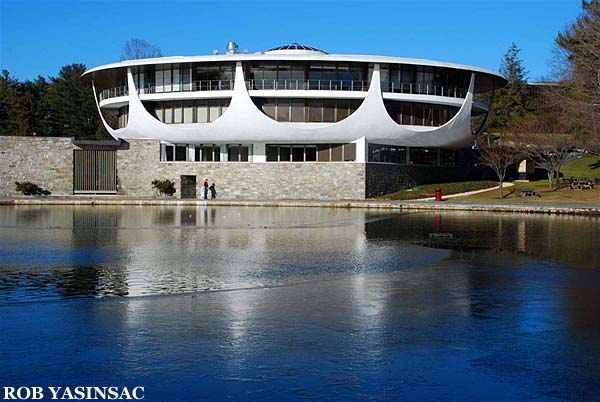
2 High Ridge Park
This past Friday was one of those awesome cold steel January days – blue skies, no clouds, no moisture in the air – perfect for photography, and in particular for photographing the gleaming white concrete and glass facades of High Ridge Park in Stamford, Connecticut. I was introduced to this location in a brief visit about five or six years ago, but had not made it back for a photo shoot in the interim.
It may be true that ten or fifteen years ago myself and other fans of old stone Italianate mansions and brick factory buildings might have despised such buildings, but now I am really taking a liking to mid-century Modernist architecture. The future that these buildings predicted never really developed, and most office buildings of the end of the 20th century lack the imaginativeness and playfulness of places like High Ridge Park. Thus they are relics of a specific short period in time when buildings of their type were common, but now they might be considered rare. Also, they soon will be nearing that 50-year ago requirement when buildings can generally be considered “historic” for landmarking or historic registry purposes.
High Ridge Park is among the earliest and spaciest office campuses. By the 1950s and 1960s, corporate executives began to prefer the suburbs for full-time homes, and then they moved the office out of the city too. The chosen site for High Ridge Park was right next to the ramps of the Merritt Parkway. Rising architects, like Victor Bisharat who had just displayed his work at the New York World’s Fair in 1964, were chosen to design the new corporate campuses. Bisharat, architect of the Pavilion of Jordan, designed the six buildings at High Ridge. The first building opened in 1967. The centerpiece of the campus, Building Number 2, has often been described as a flying saucer. Buildings 1 (c. 1967) and 3 (c. 1969) could have been the first moonbases – it was that moment in time when we got there.
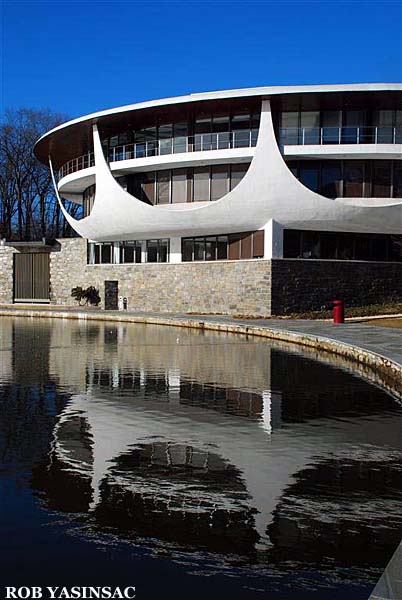
2 High Ridge Park
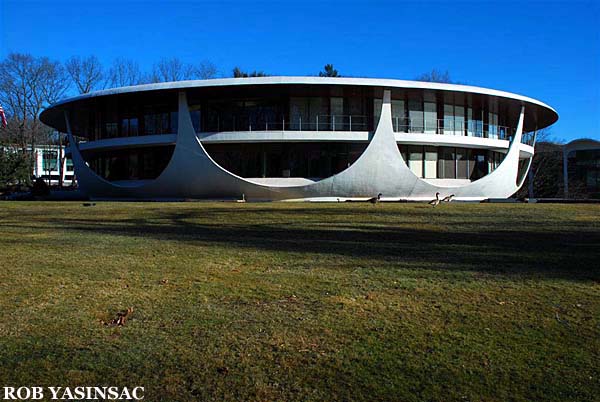
2 High Ridge Park
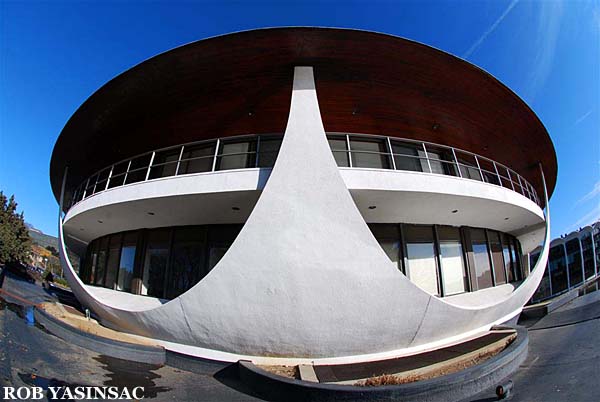
2 High Ridge Park
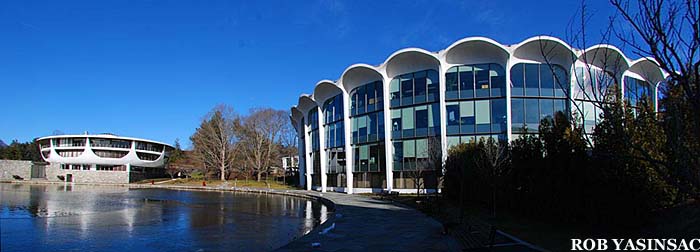
2 and 4 High Ridge Park
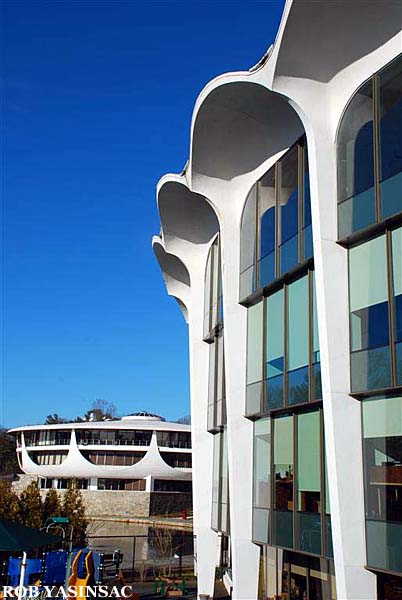
2 and 4 High Ridge Park
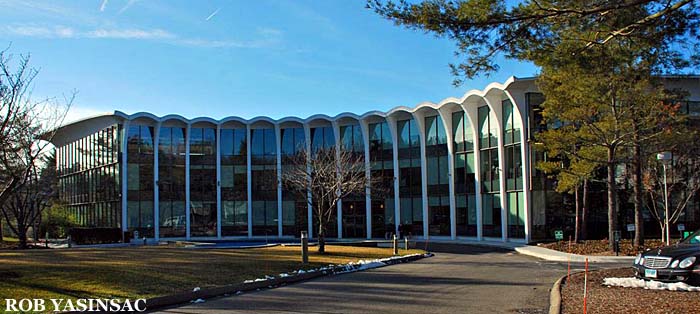
4 High Ridge Park
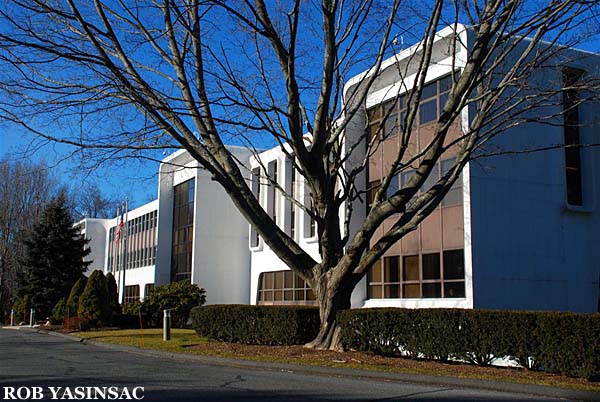
3 High Ridge Park
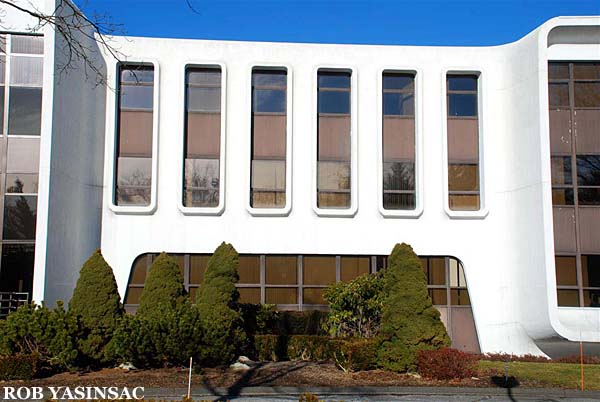
3 High Ridge Park
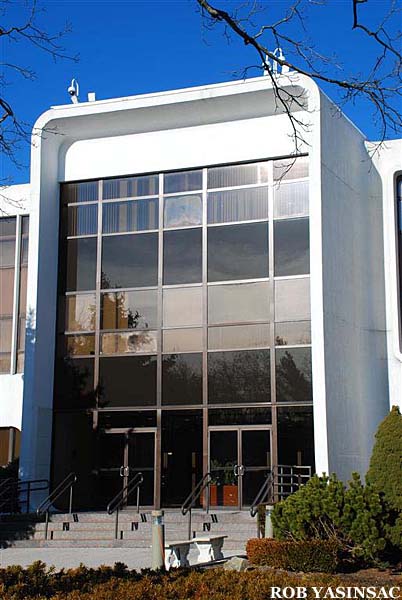
3 High Ridge Park
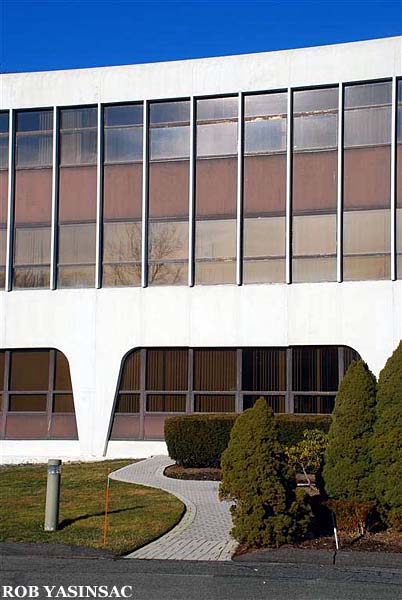
3 High Ridge Park
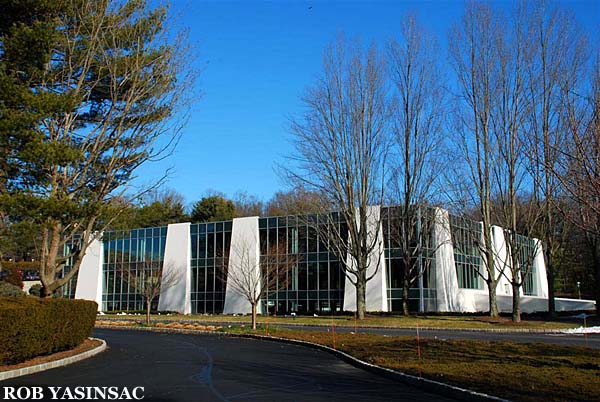
1 High Ridge Park
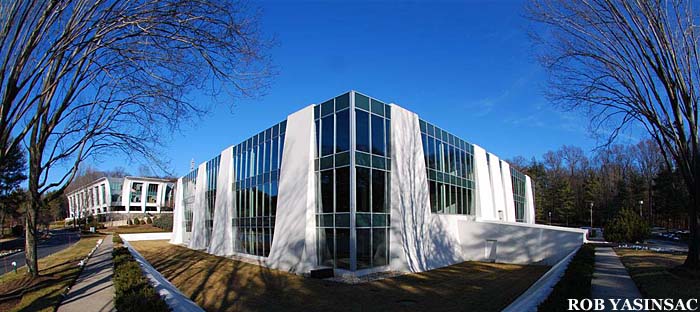
1 and 5 High Ridge Park
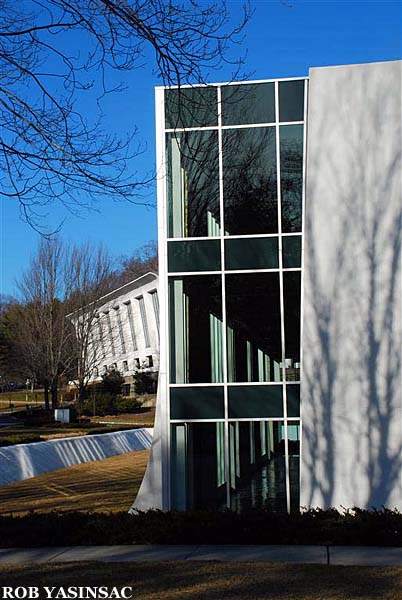
1 and 5 High Ridge Park
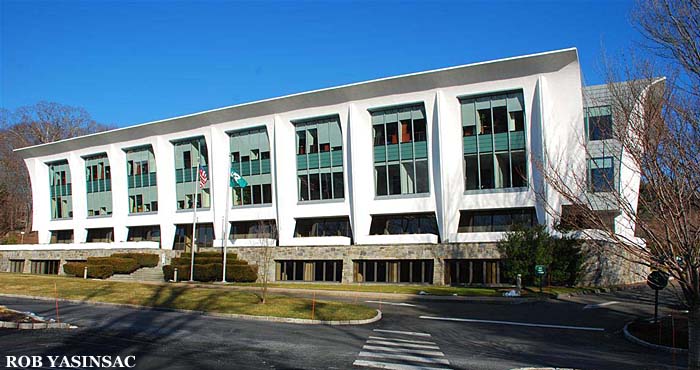
5 High Ridge Park
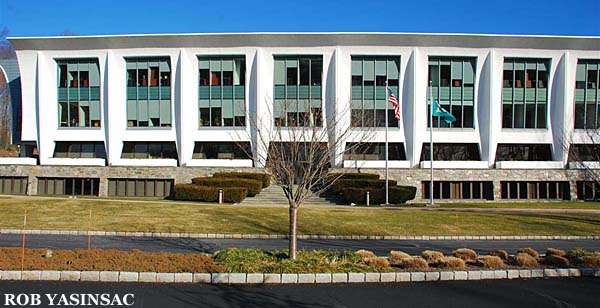
5 High Ridge Park
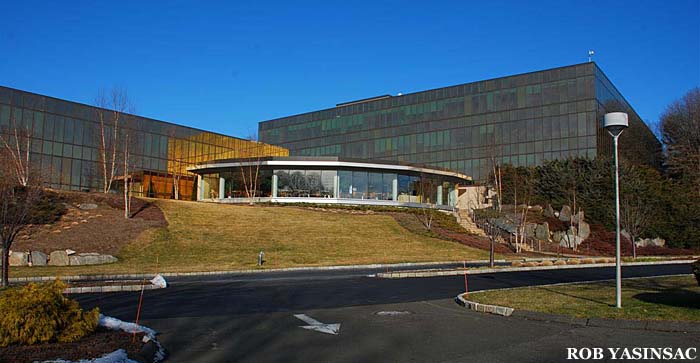
6 High Ridge Park
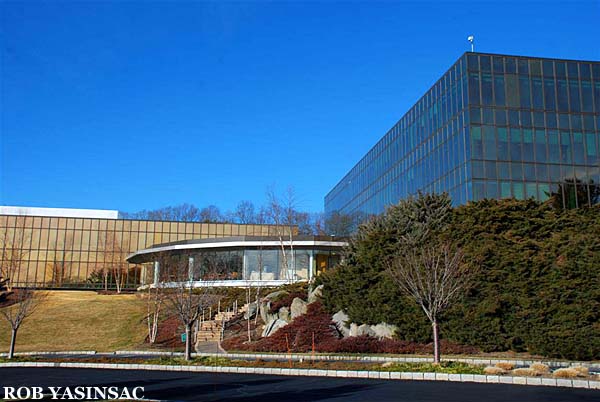
6 High Ridge Park
See the tan walkway at center, from the building to the road? I should have gotten a close-up photo. It is a walkway to the cafeteria (building portion at center). Funny thing is, there is no sidewalk there. The walkway goes right to the street. Is there some kind of shuttle service that drops people off at the cafeteria walkway? Or are employees expected to walk in the roadway and dodge SUV traffic on their way to lunch?
Despite recent renovations to the buildings, the park itself is not really park-like, and in fact is rather pedestrian-unfriendly. I spent most of my time going from building to building via parking lots. I’m surprised that security guards did not come out to assess my presence, as clearly no one gets out and walks around what little grass there is here.
Further Information:

holy barf, batman! ughhhh
lol, there is some stuff like this in Livonia (Metro Detroit) where i grew up, and i have never really liked it. in fact, (lol), it was this kind of architecture that made me fall in love with victorian, beaux-arts, art deco, and romanesque architecture, hahahaha!
theres a very few blgs like this that i can even really tolerate. i must say i do like a lot of Minoru Yamasaki’s stuff (the guy who designed the World Trade Center)…he left quite an imprint on Detroit actually…probably more than any other city. his influence is especially noticeable on Wayne State University’s campus.
Haha… I know, I’m putting my reputation on the line here. Just wait ’til you see the next couple of examples I plan to post. I’ve been on a little kick lately… Now I’m not appreciative of every modernist building, but some examples have their place in history. And like I said, years ago, I would not have been a fan. I’m jumping on the bandwagon in fact; the New York times did a piece on “The Office as Architectural Touchstone” in 2008. And John Zukowski (or was it Frank Sanchis?) called the office parks the successors to the great estates as the examplars of architectural design in the Hudson Valley (and elsewhere). (Damned if I can find that original quote, but that’s how I remember it.) And some of those buildings make good ruins too.
Whoa, that Wayne State building is cool! Now that’s holy Batman!
yeah i guess i can say that this type of architecture has a place in my heart, but only on a cursory or sentimental level.
i want to say that there was more of Yamasaki’s work at WSU, such as the McGregor Conference Center…i know he has several more intriguing blgs in the metro-detroit area.
wow, that weird modern blg at Hudson Valley is a trip! i walked past it when i was there without going inside. i do definitely appreciate some modern architecture. but it’s the older stuff that really is my bread & butter.
Hands in the air! A “landmark” post Rob…
Thanks for the encouragement Tom!
This park really has a great feel – and I love that each building is different. The landscaping looks much better in the spring. Our offices used to be in Building 5 – if you look at old photos, it is clear that while there are some enhancements and advances, the look and feel of the historical buildings has been maintained….
Thanks – I’ll try to visit when there is some greenery (or other colors) around the buildings. I don’t think I’ve seen other photos besides those in newspaper articles, which are not very old.
I lived in the area when these buildings went up. Close by, but not in the park, is a seventh building. At the time it was the Schweppes Building, and my mother worked there for a few years.
IIRC there was a moat around the #2 HRP building that was not filled. We would ride our bikes in it.
At certain times of the year #6 is spectacular at sunset, as the gold tint of the windows reflects the sunlight from darkened offices, but show through for the lit ones.
At the time we all felt that we were incredibly modern!
Thanks for the info! I have photographed that other building too, but I did not know it was the Schweppes office. Stop by and enjoy a glass of Schweppes ginger ale.
Below is a partial repro of an article that appeared in the February 2011 Edition of Stamford Magazine.
Victor Bisharat designed many of Stamford’s notable buildings. Building one in High Ridge Park is just one of the many unusual ones. You can add the Landmark Square Building & the former GTE (now Purdue Pharma) Building which resembles an inverted pyramid. His designs were far ahead of the times for sure and I for one think that while they are a bit unusual, they beat the hell out of the boring, faceless, colorless buildings that have been or are currently being constructed on every corner of Harbor Point or Washington Boulevard in Stamford!
STAMFORD LANDMARKS
If Geller played a supporting role in shaping Stamford’s skyline, the late Victor Bisharat, who designed Landmark Tower, and other buildings, was the star.
Born in as-Salt, Jordan, Bisharat took an early job with the Ralph M. Parsons Company, for which he helped transform an Anaheim orange grove into Disneyland, according to his family. But, while it may be tempting to connect the dots between the minimalist monorail tracks of Disney’s original Tomorrowland and, say, the long, unadorned fins running up and down the Landmark façade, park officials couldn’t confirm Bisharat’s employment.
A more credible precursor, and a possible foreshadower of what was to come, was Bisharat’s creation for the 1964 World’s Fair in Queens, New York—the Jordanian pavilion, with a rippling, mounded roof pierced with hexagonal skylights that mimicked the original seven hills of Amman, Jordan.
Constructing that unconventional surface fell to Stamford’s F. D. Rich Sr., then a contractor hoping to expand into development who invited Bisharat to relocate to Connecticut. Practicing what he preached, Bisharat settled into a Richard Neutra–designed Modernist house, whose chocolate-colored cantilever over a carport still dazzles at the end of Brookhollow Lane.
Bob Rich, the current chairman of F.D. Rich Company, admits that critics didn’t immediately cotton to Bisharat’s outlandish style, though “the public not only liked it, they loved it.” Rich says that people waited in line for hours to visit their first collaboration, High Ridge Park, when it opened in 1967.
A thirty-eight-acre office complex, High Ridge Park boasts buildings resembling TV sets and others with bubble-wrap skins tucked improbably among pines. An ongoing, $10-million-plus renovation that began in 2004, after Rich sold the complex to a partnership of George Comfort & Sons and Angelo, Gordon & Company for $79 million, has altered many of the buildings as it has peeled back stucco while adding windows.
Yet many aspects of High Ridge Park are still mesmerizing, like the somewhat anticlimactically named Building Two. Squashed and round like a Tupperware bowl, and topped by a tiny glass dome, the three-level space is perched over an artificial pond on one edge and ringed by a moat at the entrance. To get in tenants must cross a gangplank.
Bisharat customized the interiors for clockmaker General Time Corp. with sumptuous attention to detail, adding rosewood desks, green leather filing cabinets and nineteen hand-carved teak doors, which depicted the histories of the countries where the company had offices. To enlarge the space, many finishes were stripped out over the years, though some doors have been socked away. Two can be found on the second floor of downtown’s University of Connecticut branch, while another pair is at the Palace Theatre.
FUNCTION TRUMPS FORM
Modern tastes and Modernism don’t always make the perfect cocktail. It’s why Reckson/S.L. Green decided to renovate Landmark Tower, a twenty-two-story obelisk whose flared, sugar-colored façade, turned 45 degrees from Broad Street, might seem right at home in Dubai. In 1997 the building, which was suffering from low occupancy rates, underwent a massive makeover in which a sunken skating rink at the corner of Atlantic and Broad streets was filled and replaced with a row of shops.
Around the same period, four smaller office buildings by Moshe Safdie were clustered around the base of the Landmark, but the tower’s sinuous lobby, with crescent swoops that evoke the rim of a shell, wasn’t touched.
In 1973, when the Landmark debuted, it loomed over downtown. In fact it was the state’s tallest building outside Hartford until Trump Parc opened in 2009. But as other highrises sprouted, its sense of dominance ebbed.
In an April 1981 letter to the New York Times, Bisharat himself seemed to bemoan that the overcrowding had kept the Landmark from being the landmark it was meant to be. “I turn the other way when I pass it on the highway,” Bisharat wrote, referring to Stamford’s downtown, adding that it had become marred by a “jarring lack of harmony.”
Were he still writing letters, Bisharat also might have had misgivings about changes at St. John’s Towers, his trio of “corncob” apartment buildings—also developed by F.D. Rich—at Tresser and Washington boulevards that, besides Chicago’s Marina City, are likely the country’s only cylindrical multifamily homes. Last year a platform-supported park between the pair of towers along the south side of Tresser had to be torn down because it was crumbling, and a footbridge over Tresser showing similar wear and tear could soon come down as well, building officials say.
In a move that seems borrowed from a Jetsons set piece, the platforms and bridges Bisharat designed had been installed to allow workers and residents to pinball between the buildings without setting foot on crime-prone sidewalks.
Indeed, witness the huge raised platform that still envelops Bisharat’s One Stamford Forum, a glassy upside-down ziggurat known as the General Telephone and Electronics, or GTE, building, when its ribbon was cut in 1973. Plus, elevating people one flight allowed parking lots to be placed closer to the building’s front doors, in a line of thought that sums up Modernist architects’ outlook on what should go where—form follows function whenever possible.
But while the platforms at St. John’s Towers may have failed, Stamford did gain distinctive structures says Anne McNamara, a twenty-year resident and the current occupant of a 1,200-square-foot two-bedroom there. Sure, corner china cabinets have a hard time fitting with walls that slightly arc, McNamara explains, but the panoramas are stunning: “The sun rises on my left. I turn my head six inches to the right, and I get to watch the sun set, without moving. “You can buy a $10 million penthouse in Manhattan and not have that.”
The view almost changed drastically in 2007, when, faced with the need to make expensive renovations to the outsides of the towers, owner St. John Urban Development Corp. decided to sell the northern tower for $23 million to allow for three thirty-five-story buildings—likely of the rectangular variety—from developer Lowe Enterprises. The downturn put the kibosh on that. Similarly, last September federal restrictions that protect the complex’s 360 middle-income units expired, meaning that the owners could put St. John’s on the auction block, but barring a sharp economic rebound, that’s seen as unlikely … for now.
BEDAZZLING
Though not everybody agrees that Bisharat’s buildings are worth savoring, or even saving, there’s one point of agreement between conservatives and the avant-garde alike—the First Presbyterian Church on Bedford Street, designed by Wallace K. Harrison, is a sui generis modern marvel.
Tucked into a slope, the 1958 building from afar can seem like one of those oversized boulders strewn along Stamford’s backcountry roads, owing to its beveled gray surface, which in parts is shingled in bluestone.
Inside, though, awaits an explosively different sensory experience. Embedded in walls that are angled like a tent’s is a startlingly vivid array of 20,000 red, green and blue glass chunks that, when the light is right, give you the impression of standing inside a finely cut, sixty-foot-tall jewel.
Such a radical rethinking of how walls and windows should relate was a trademark of Harrison’s. His Hall of Science for the 1964 World’s Fair has eighty-foot walls spangled with rows of blue-glass shards. Having also designed the Buck Rogers–inspired Trylon and Perisphere exhibits at the 1939 World’s Fair, also in Queens, Harrison could be said to have created the two bookends of the Modernist movement.
Still, Harrison, who also worked on the United Nations building, called the Presbyterian Church his favorite work, according to Victoria Newhouse’s 1989 book Wallace K. Harrison, Architect, which also debunks a popular myth: Though known as the “Fish Church” for its piscine silhouette, that wasn’t Harrison’s intention. In fact, early sketches reveal it as more of a bowling pin.
While their charms bode well for the future of design and may have growing appeal here and elsewhere, Stamford’s wiggly-weird structures do seem to have caught on already with a specific group: architects who now do with a computer what many old-timers in Stamford had to dream up in their heads. And that may be the city’s most lasting legacy. “The buildings show an experimental way of thinking, before experimental was mainstream,” says Victor’s son Tobias Bisharat, also an architect, invoking Frank Gehry and his crumpled-paper-like façades. “They were a taste of what was to come forty years later.”
Thanks for the article Ron!
We relocated our corporate hq from downtown Stamford to High Ridge Park. Think and say what you want, but HRP is a really nice environment compared to the noise of downtown. Every employee who works for our firm loves the new location. We overlook the fountain in the man-made lake and it’s wonderful in the spring, summer, fall. To be able to look out your window and see deer is something no downtown location can ever offer. There’s a lot to be said about a more relaxing, less stressful work environment that’s kind of cool and certainly different.
Sounds like an awesome place to work!
I beg to differ, not only are we used to seeing people walking around taking photos for various reasons, but we also do have security guards driving around, whom unless you are acting suspiciously will leave you alone. We also have people walking around everyday, even in the bitter cold. The sidewalk to no where? Leads to the cafe and the sidewalk runs around most of the park….and yes there is shuttle service at each building location. You can appreciate the beauty and architecture but seem to be negative of the rest of the park…Why don’t you come back during a nice spring day during the work week (non holiday) My only warning is the speeding cars, only a few actually abide by the posted speed limits of the park, crosswalks aren’t safe either, nearly been run over by speeding cars.
My comment about the “sidewalk to nowhere” was not about the building end of the path, but the street end – there is no pedestrian walkway parallel to the road, so the only way to get to the path that I saw then was to walk in the road, as I had to do and which is, as you pointed out, not a safe prospect. I love the aesthetics of the park, I just think the functionality could be improved for pedestrians. Thanks for corroborating that point.
I was one of the designers of #3,4 and St Johns and Landmark Sq. Know most of their history…..email me if you wish….Ed
Pingback: Misfits’ Guide to DUBAI | misfits' architecture
I grew up right over on Vine Road, and had relatives living at the fire department as dispatchers, and still never knew about this place until I was a tween (around 1980). A friend of mine and I found a little roadway off of Turn of River that led to a dead end, but at the end of that you could see these buildings. We were completely in awe! It was like we had found some hidden compound in some cool science fiction novel. We rode our bikes around, enjoying all the bizarre buildings and, of course, that funky round one was my favorite. I remember going home excitedly, ready to dazzle my Mom with my discovery about this amazing place and she was like “oh yeah High Ridge Park” shrug. Lol!
Thanks for sharing your memories. I can imagine finding this place as a kid and thinking how spacey and cool it is!
I grew up in that neighborhood in 1960s-70s & in a naturally childish way, was impressed (a little) by these buildings. They now remind me of hamburger drive-ins from that brief and dubious era (a dead end). I believe today HRidge park is economically borderline I doubt its historic/aesthetic value is in any actual sense, greater than its value as a real estate proposition. This suggests another teardown, still very typical of Stamford. Note: Your “6 High Ridge Park” was constructed around 1980 and is conceptually & temporally separate from “High Ridge Park” (but probably not officially separate).
Thank you for your comments and info about #6.